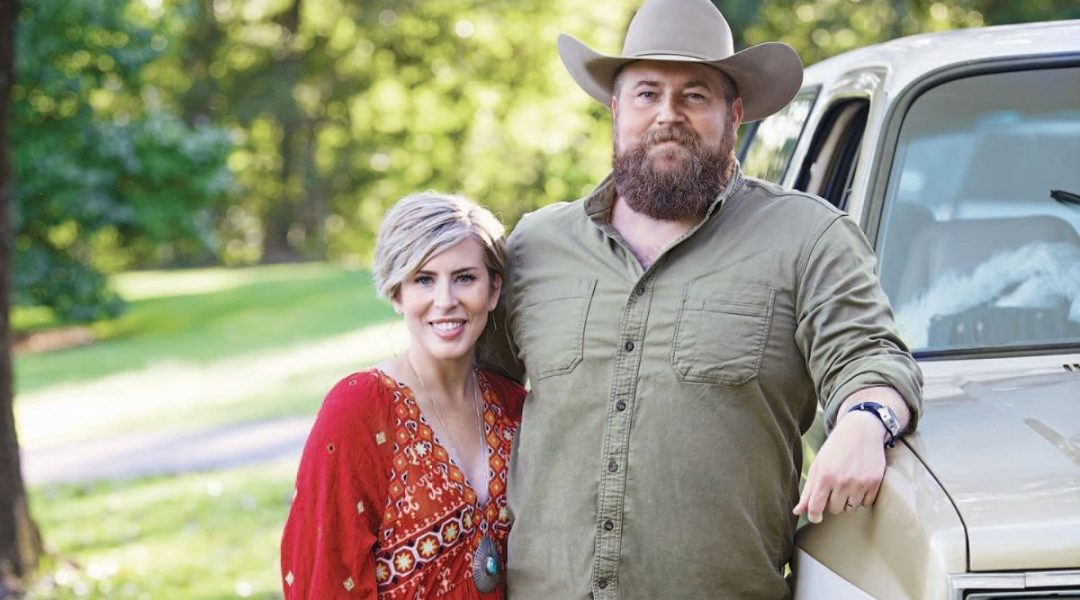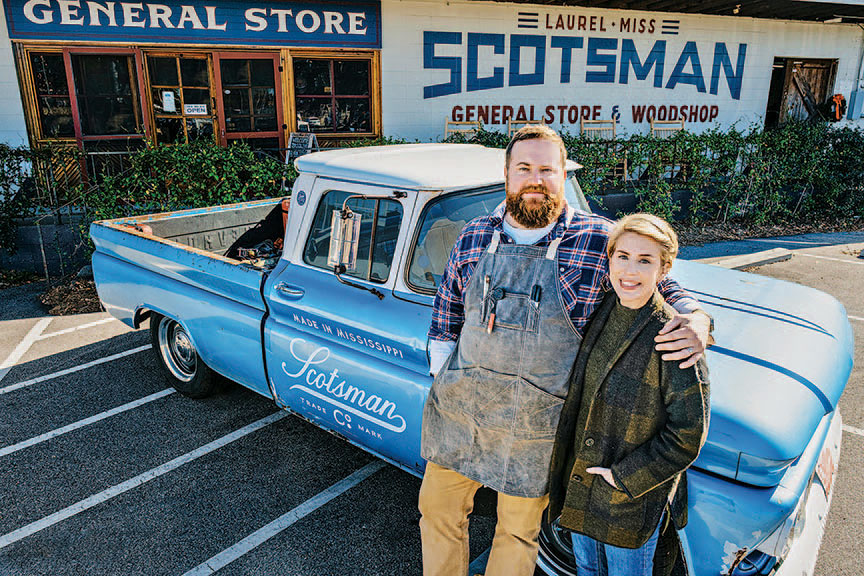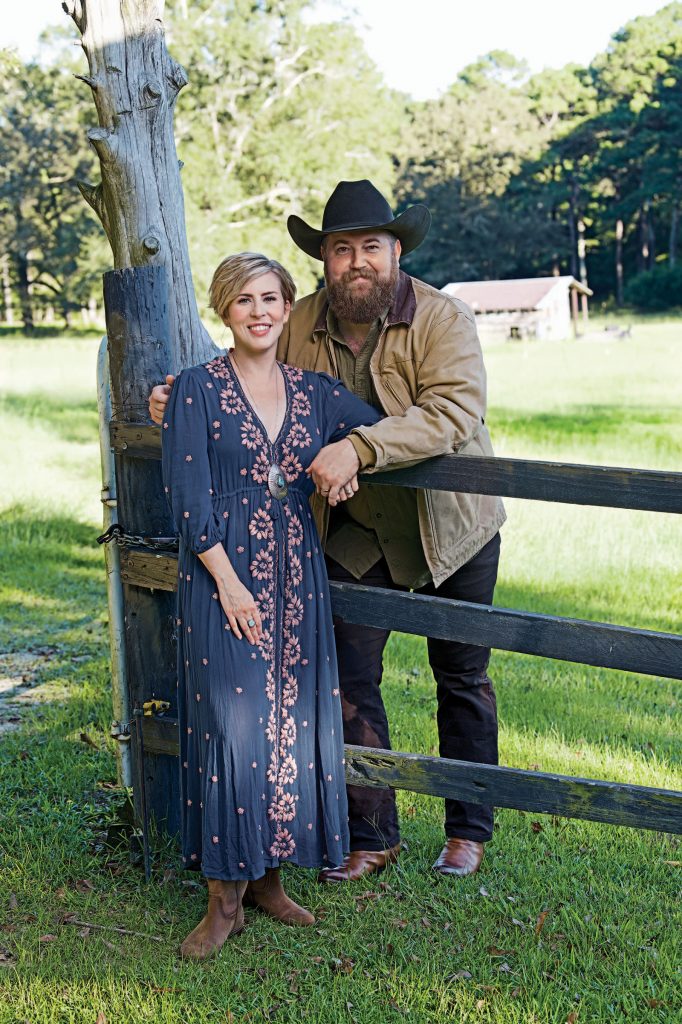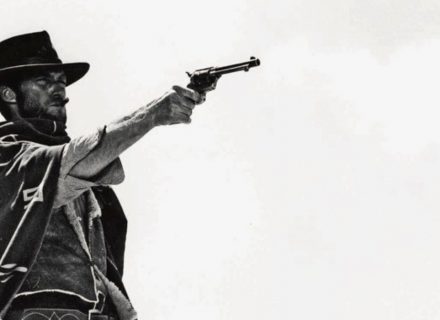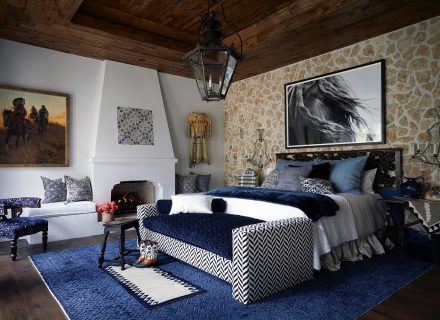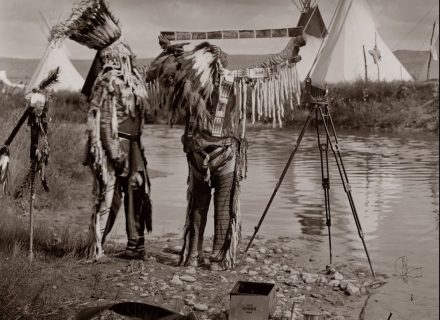The Home Town heroes of Laurel, Mississippi, let us in on why they love their slow-moving small town, what home means to them, and why they fiercely champion American manufacturers every chance they get.
2021 was a year of big debuts for HGTV superstars Erin and Ben Napier. Not only did the home-renovating power couple premiere three new shows (season five of Home Town, the brand-new Ben’s Workshop, and the six-part docu-series Home Town Takeover), but they also welcomed a second daughter (baby Mae, sister to 4-year-old Helen). These days, though, action-packed years are nothing new to the Napiers — not since HGTV came calling in the summer of 2014. Back then, Erin owned a stationery company, and Ben had just left his job as a youth minister to embark on a woodworking business. Together, they had renovated a 1925 Craftsman cottage in Erin’s sleepy but charming hometown of Laurel, Mississippi (population 18,338), and when the house was featured in a regional magazine, it caught the eye of an HGTV producer. “We thought that she was going to order stationery,” Erin says of receiving the producer’s initial email. “And then, when it turned out that she was interested in pitching us as a TV show, we just didn’t put any kind of faith in that. We were just like, ‘There’s no way this’ll ever happen, because this doesn’t happen to people who live in Laurel, Mississippi.’ And things just kept happening.”
In January 2016, the Home Town pilot aired to 2.2 million viewers, making it the highest-rated pilot in the network’s history. The full first season — following Erin and Ben as they revitalized seen-better-days houses throughout Laurel — debuted the following year. Since then, the Napiers have been in high gear, opening two stores in Laurel and publishing a memoir along the way. Now, this January — on the heels of the second-season premiere of Ben’s Workshop, available on Discovery+ and featuring Ben swapping stories with and teaching carpentry to celebrity guests — HGTV is set to air season six of Home Town. And in May, Erin will release her first children’s book. Titled The Lantern House, the illustrated book, unsurprisingly, is a celebration of home.
Photography: Courtesy Discovery+
Looking back on those early days of shooting the Home Town pilot, Ben remembers some advice their production company gave them — advice they took to heart and have followed since day one. “They were incredible at managing our expectations and not saying, ‘Oh, this is a hit,’” he says. “It was very much like, ‘OK. You never know what the fans will like. This could be over tomorrow, so just have fun with it.’ So that was what we did, and that’s still what we’re doing.”
C&I recently caught up with the Napiers on a lunchtime Zoom session from their Laurel studio. (DoorDash is the friend of busy TV stars, too, it turns out.) Here are some highlights from our conversation.
Cowboys & Indians: Now that you’ve got two kids, is a bigger house maybe in the cards?
Erin Napier: Yes. We’ve bought a country house, and we plan to make that a place where we can let them get dirty, climb trees, fish, and make mud pies. Living in town, they don’t get that opportunity, and we just want them to have outside space to be kids.
Ben Napier: We’re keeping our house in town, and we’ll split our time. ...For me, since pretty much I believed I was going to be a Wild West cowboy for much longer than I should have — not like I was going to own a ranch and have horses and cows. I believed I was going to be a gunslinger living in the Wild West, which didn’t exist anymore, for way longer than I should have. But I’ve also always wanted to have horses and always wanted to have cattle, and Helen is obsessed with this also.
Erin: She loves horses, and I’m deathly allergic. But Ben loved them growing up, too, and so I think the plan is there’s going to be a horse at some point.
Ben: Horses. Plural. Have we confirmed that you’re allergic to horses?
Erin: It’s horses and cats, man, horses and cats. No, I am for sure. So we’re going to have some land in the country, and we’re excited about that.
I believed I was going to be a Wild West cowboy for much longer than I should have — not like I was going to own a ranch and have horses and cows. I believed I was going to be a gunslinger living in the Wild West, which didn’t exist anymore, for way longer than I should have. –Ben
C&I: Does this house have to be restored?
Erin: Yes, we’re going to renovate the interior, and people are going to see that on HGTV.
Ben: It is already a beautiful old house, and it’s honestly a dream situation for us. So to be able to find it and now get to renovate it —
Erin: It’s going to be fun.
C&I: So, what can we expect from season six of Home Town?
Ben: We’re doing more country houses.
Erin: We have some friends who started a tea farm, and there’s a little house on the property where the farm is, and we’re going to get to renovate that.
Photography: Mike D’Avello
C&I: Ben, what’s coming up on the new season of Ben’s Workshop?
Ben: It is all of my hobbies and likes matched together into one show. I love meeting new people, and I love learning about them and connecting with them, and I love building furniture and designing new pieces and building them and diving into joinery. And I also love cars. Last season was the first one, and it was four episodes, and we were trying to figure it out. This season, almost every episode, we have delivered the piece of furniture in some weird, unique vehicle. The way we describe it is it’s Comedians in Cars Getting Coffee meets The New Yankee Workshop.
C&I: Besides what we see on the show, what else do you and your team make in the workshop?
Ben: The shop has been serving basically three purposes. One, we design and build furniture for everyone on the show. This year it’ll end up being close to 75 custom pieces of furniture. But we also are a film studio because we film it. And Scotsman General Store is connected to our wood shop, and you can watch us building things. The business mind behind that is they’ll see us making things and they’ll want to buy something. We’ll have cutting boards or rolling pins or something, but we have to make those on top of making TV shows and making furniture.
Erin: We’re actually going to be opening a new business soon. We’re starting a manufacturing facility.
Ben: Yeah. We’re building a factory here in Laurel. You’ll be able to buy butcher block countertops or just big butcher blocks or cutting boards. We had outgrown our shop, and rather than just build another small shop, we looked at it and we think that we can really make a go at this. And so we’re building a pretty big factory.
C&I: You also have a furniture line with Vaughan Bassett, and you’ve said you partnered with them because of the fact that everything’s made in America.
Ben: Galax, Virginia, is an incredible town. I think the population is like 6,000 people, and 600 of them work in Vaughan Bassett’s furniture factory. So a tenth of the population works for them, and so everyone in that community is connected to that factory, and the town is thriving because of it. That’s something that when we started this, having a show called Home Town about restoring a small town — I was on the phone with someone, and they were trying to get us to promote something that was made in Asia. And I said, “This is not a political fight for me; this is not a political argument for us. It’s simply that if we’re going to say that we are trying to save small-town America, we’re trying to rebuild small-town America, then we have to be serious about supporting American manufacturing because those towns depend on it.”
Laurel depends on it. We have several manufacturers that build things here, and if it weren’t for them — if you think about a house, when people say, “This house has good bones, and it’s got a lot of potential,” well, when we started this project here in Laurel before HGTV found us, this town had good bones, and it had a lot of potential because the factories were still here, and they were still employing people. People had jobs; it was just a matter of making it more interesting for people to live here.
Photography: Courtesy HGTV
C&I: What is it about small-town life that you two love so much?
Ben: It is very slow here, and we like that. At times, it is hard with our career because it is so slow.
Erin: Yeah. It’s hard to get to an airport. It’s hard to find people who’ve worked in the TV industry who know what kind of help we need with certain things. But other than that, just the thing that makes living in a small town wonderful is familiarity and tradition, I think. There’s a comfort in things. Like, there’s an elderly man who lives near us who has Alzheimer’s, and everybody in the neighborhood keeps an eye on things at their house. Sometimes we’ll see him raking at night in his yard, and we know we need to talk to his wife and get him home. I don’t know if that happens in a big city, if everyone feels a responsibility to their neighbors in the way you do in a small town.
C&I: Speaking of the people in Laurel, has everyone there embraced the show, or are there some that have not been welcoming of the attention?
Ben: It’s a mixed bag. The majority of everyone here loves it and is happy with it.
Erin: And there are people who hate change. You know there’s always going to be some old sore heads everywhere you go. That’s to be expected, I think. There were a few people who were happy for it to be stagnant and for Laurel to eventually just wither.
Ben: But I don’t think that that’s even it. I think that there are just people in the world who thrive on being negative and complaining, and they complained about it being stagnant and dead.
Erin: And now they’re complaining because there’s nowhere to park.
C&I: So, are you getting a lot of tourists now?
Erin: It is wild with tourists, yes. But tourists are doing a great thing. The sales tax for the city is higher than resort cities in the South, and there’s so much good that can come from that for Laurel and infrastructure.
Ben: We had a record-breaking month this summer, where it was the highest sales tax the city had ever made in the history of Laurel. And so that’s exciting because that is some real change that you can see in a small town.
Photography: Mike D’Avello
C&I: One of my favorite things about the show is how you share the histories of the houses and the people who lived there, which is kind of different from a lot of other shows like this. Why is that important for you to include?
Ben: It’s just the reality. Think about it — you have memories connected to houses based on the people that lived there. In some cases, you have memories of houses because Oh, that was a really beautiful house that I drove by every day. Our house was Erin’s dream house when she was a little kid. And we know that the house on the corner is the McLeod’s house. That’s how we, in town, describe it. And when we first started talking to producers, that’s how we explained it to them: “Oh, yeah. So-and-so lived in this house for a while.” That’s part of it, but then for the people who are connected to those houses, it’s a way that they are remembered.
Erin: So it’s important that when we talk about the changes we want to make to these houses that we’re sensitive to that because these people, we’re going to see them or their grandchildren in the grocery store. And we never want to be that show where we’re like, “Isn’t this hideous? I hate this. I hate that,” because it was a special choice to somebody else who made it, and we’re going to know those people. We want to always be respectful.
C&I: Erin, this last question is for you: Do you try to make people cry on Home Town?
Erin: I feel like that’s the only kind of home show I’m interested in, something that is emotionally significant — that’s all home is to me. For instance, I can’t even talk about what’s going to happen one day when my parents finally don’t live in their house and they sell it. The house I grew up in, that they’ve been in for 30 years — I’m not able to even talk about that someday loss. I think that a home is a lot more than the way it looks. It’s more than a Pinterest board; it’s more than a magazine. Home is a feeling, and that means tears sometimes, doesn’t it? People are still talking about our friend Kendall and the quilt. I don’t know if you saw that episode.
C&I: Yes, that’s one that really tore me up. [In the episode, Erin surprises the homeowner with a quilt embroidered with messages from her late husband’s old letters, stitched in his handwriting.]
Erin: Yeah, it tore up a lot of people. It tore us all up in real life, too, when we gave it to her. That’s what home is. That’s the place where you’re comforted. It’s where love lives in your memories and your history, so that’s all emotive stuff. It just is a byproduct. Tears happen.
From our January 2022 issue
Photography: (Cover image) Mike D’Avello






